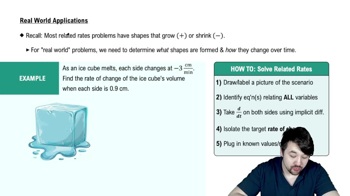Table of contents
- 0. Functions7h 52m
- Introduction to Functions16m
- Piecewise Functions10m
- Properties of Functions9m
- Common Functions1h 8m
- Transformations5m
- Combining Functions27m
- Exponent rules32m
- Exponential Functions28m
- Logarithmic Functions24m
- Properties of Logarithms34m
- Exponential & Logarithmic Equations35m
- Introduction to Trigonometric Functions38m
- Graphs of Trigonometric Functions44m
- Trigonometric Identities47m
- Inverse Trigonometric Functions48m
- 1. Limits and Continuity2h 2m
- 2. Intro to Derivatives1h 33m
- 3. Techniques of Differentiation3h 18m
- 4. Applications of Derivatives2h 38m
- 5. Graphical Applications of Derivatives6h 2m
- 6. Derivatives of Inverse, Exponential, & Logarithmic Functions2h 37m
- 7. Antiderivatives & Indefinite Integrals1h 26m
- 8. Definite Integrals3h 25m
4. Applications of Derivatives
Related Rates
Problem 13c
Textbook Question
The legs of an isosceles right triangle increase in length at a rate of 2 m/s.
c. At what rate is the length of the hypotenuse changing?
 Verified step by step guidance
Verified step by step guidance1
Identify the relationship between the legs of the isosceles right triangle and the hypotenuse using the Pythagorean theorem: if the legs are of length 'x', then the hypotenuse 'h' can be expressed as h = x√2.
Differentiate both sides of the equation h = x√2 with respect to time 't' to find the rate of change of the hypotenuse: dh/dt = (d/dt)(x√2).
Apply the chain rule to differentiate the right side: dh/dt = √2 * (dx/dt), where dx/dt is the rate of change of the leg length.
Substitute the known rate of change of the leg length (dx/dt = 2 m/s) into the differentiated equation to find dh/dt.
Calculate the value of dh/dt to determine the rate at which the hypotenuse is changing.
Recommended similar problem, with video answer:
 Verified Solution
Verified SolutionThis video solution was recommended by our tutors as helpful for the problem above
Video duration:
2mPlay a video:
Was this helpful?
Related Videos
Related Practice






